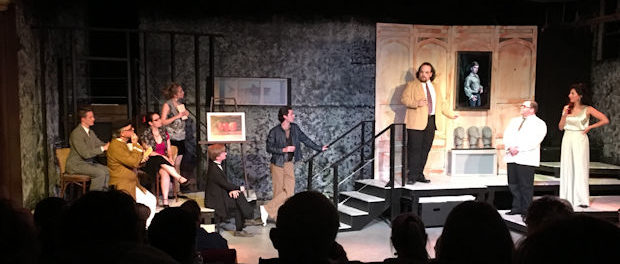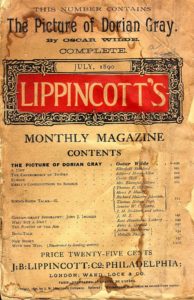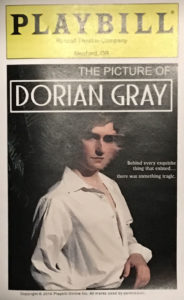Randall Theatre’s The Picture of Dorian Gray
 Cast of Randall Theatre's The Picture of Dorian Gray on stage, left to right: Isaiah Brown (Fritz), Robert Fort (Theodore Ruzpin), Brittany Hreha (Maria Bella), Alexandra Bringer (Ellie Gardner), Nico Hewitt (Dorian Gray), Rhyon Ingalls (Alan Campbell), Jon Oles (Harry Wolton), Jeff Mercer (Basil Hallwood), Mia Gaskin (Victoria Frost). Not pictured: David Hagemaier (Detective Trevor Morse), Suzie Gabumpa (Sybil Vane & Karen Oliver), Meagan Kirby (Christina), Brad Zentgraf (James Vane)
Cast of Randall Theatre's The Picture of Dorian Gray on stage, left to right: Isaiah Brown (Fritz), Robert Fort (Theodore Ruzpin), Brittany Hreha (Maria Bella), Alexandra Bringer (Ellie Gardner), Nico Hewitt (Dorian Gray), Rhyon Ingalls (Alan Campbell), Jon Oles (Harry Wolton), Jeff Mercer (Basil Hallwood), Mia Gaskin (Victoria Frost). Not pictured: David Hagemaier (Detective Trevor Morse), Suzie Gabumpa (Sybil Vane & Karen Oliver), Meagan Kirby (Christina), Brad Zentgraf (James Vane)
Randall Theatre’s The Picture of Dorian Gray: Intense, Thinking Persons’ Theater
– by Lee Greene
I attended the opening performance of Randall Theatre’s production of The Picture of Dorian Gray on Friday, September 23, 2016. The source material for the play is Oscar Wilde’s initially magazine-published (Lippincott’s Monthly Magazine, The Picture of Dorian Gray, July 1890] and then book [1891] novel, The Picture of Dorian Gray.

July 1890 issue of Lippincott’s Monthly Magazine presenting the original version of Oscar Wilde’s The pictyre of Dorian Gray
Wilde’s novel was a controversial, philosophical contemplation on aestheticism, self-indulgence, and moral duplicity, with references to homosexuality, homoeroticism, debauchery, decadence, sadism, all manner of immorality, and no shortage of offensive language (one cannot effectively describe debauchery without language which will be offensive to some!), which shocked the literary world at the time of its publication (“so controversial that the W H Smith publishing house withdrew every copy of the July 1890 issue of Lippincott’s Monthly Magazine from its bookstalls in railway stations” [Wikipedia, The Picture of Dorian Gray, https://en.wikipedia.org/wiki/The_Picture_of_Dorian_Gray]). The aesthetic ideals and moral dilemmas depicted in Wilde’s story are universal, faced by everyone – ALL of us, and timeless. As another reviewer has written in a review of another theatrical adaptation of The Picture of Dorian Gray, “126 years after its publication, The Picture of Dorian Gray is as pertinent, modern, fresh and terrifying as when it first appeared.” [York Mix, Tanya Nightingale, Review: The Picture of Dorian Gray, http://www.yorkmix.com/things-to-do/theatre/review-picture-dorian-gray/] The behaviors and attitudes of various characters described in the novel are shocking to anyone possessing any sort of moral compass, but intended to, and effectively do, make the reader/viewer think about the moral and aesthetic choices we all face, in the course of this life.
Randall Theatre has smartly updated the story, setting it in a 1980’s America instead of a 19th century England. So the details of some of the aesthetics and debauchery have been changed to more readily be identifiable to a modern audience. Says Director Toni Holley: “We decided to do an updated 1980’s version to show the idea is universal and ageless. . . . Even more than a century later, wrong is still wrong. There are still consequences. Guilt and remorse are still valid. It doesn’t change because the era has changed.” While murder is still murder, homosexuality is still homosexuality, wanton sex is still wanton sex, etc., for a modern audience, an opium den becomes cocaine addiction, and the self-indulgent aestheticism of the characters is manifested in a pursued aspiration to create and distribute a successful Hollywood “B” movie. To complete the task of pulling the story to a 1980’s America for the audience, Randall Theatre enlisted composer Russel Medeiros to provide original background music for the production in a synthesizer-heavy 1980’s musical style.
This show is a departure from Randall Theatre’s usual fare of light, comical farces and musicals. While it does have a few comical moments and an occasional good laugh, this play is serious theater. Wilde wrote this story to induce people to think about the stark moral and philosophical choices life poses for ALL of us. Any good theatrical adaptation of the story must, at its core, do that as well. And make no mistake, Randall Theatre’s current production is quite good, and very effective at accomplishing Oscar Wilde’s objective. If you’re looking for an escapist, feel good, light comedy, or fluff musical, this show is NOT for you. Like all decent adaptations of Wilde’s work, it also includes no shortage of offensive language. It’s not frivolous usage of offensive words; the dissoluteness which Wilde is trying to present just cannot be accurately depicted without some language that will be offensive to sensitive people). If your ears are too sensitive to tolerate that, then you probably ought to stay away. But if you’re looking for a very well and creatively presented, nicely acted, thought-provoking, timeless, classical, philosophical drama – definitely make it a point to catch this show.
Now, for those interested in reading some more: an overview of the plot, and then some comments about the Randall Theatre production. Dorian Gray is a beautifully handsome, young adult man – the apotheosis of ripe male sensuality. Gray’s friend, the sensitive, and apparently homosexual, artist Basil Hallward is utterly taken with Gray’s beauty and undertakes the task of effectively capturing it in a painting. Gray is a narcissistic young man who falls under the influence of the hedonic, decadent, self-indulgent, affluent, elitist, Harry Wolton. When Hallward succeeds at producing the gorgeous portrait of the beautiful Gray, Gray realizes that his beauty will fade, while the portrait will remain beautiful forever. Gray impulsively proclaims a wish to sell his soul, in exchange for retaining his beauty eternally and the portrait instead of him aging and fading. The wish is granted – Gray continues to stay young and beautiful, eternally, regardless of whatever happens to him. The portrait, on the other hand, grows less beautiful with every less than beautiful incident in Gray’s life. Gray, indulging his uncontrolled sensuality under the influence of Wolton, courts an actress, Sybil Vane, who performs Shakespeare in a local theater. Gray takes his pals, including Hallward and Walton, to see Sybil perform Romeo and Juliet. But Sybil, who has fallen head over heels in love with Gray, can no longer do a credible job of acting the emotion of love, having been so overcome with the real emotion in her liaison with Gray. Though Gray’s friends politely, albeit faintly, praise Sybil’s awful acting, Gray is embarrassed by Sybil’s poor acting. He cruelly rebukes her, telling her that acting was her beauty and without it, he is no longer interested in her, and sends her packing. Heartbroken, she commits suicide, and Gray is subsequently informed. Guess what? The painting is no longer quite as beautiful and now sports a sneer of cruelty. And so it goes on, with Gray, egged on by his intemperate older friend, Wolton, continuing to engage in various acts of debauchery, cruelty and immorality, including murder, wanton sexuality, and manipulation of accomplices and abettors.
As the years go by, Gray remains young and beautiful, while his friends all age and fade, and the painting grows uglier and uglier. When the painting becomes more grotesque than he can tolerate, Gray decides to try reversing tact, and treating others with goodness, hoping to reverse the picture’s decay. This begins with not taking advantage of the vulnerable young lady currently offering herself to satisfy his lustful impulses: in the 1980’s version, an ingénue offering to satisfy Gray’s sexual desires in exchange for a part in the movie, which he manages to resist for a change. But when he subsequently looks at the picture, it has grown even uglier, reflecting the reality that his motivation for moral reformation and self-sacrifice is once again ultimately vain and selfish. As the story builds to its finale, Gray can stand it no further – something must be done to end what has become his eternal agony. Now my readers know full well, I am not going to give you the ending – never do. It’s not a secret – those who’ve read the novel, seen a film adaptation, or read most pieces about the work, know what happens. Still, I’m not going to include a spoiler here. If you are one of the select people who don’t know how Wilde ended his story (well and faithfully presented on the Randall Theatre stage) and desire to know how it ends, GO SEE THE PLAY!

Niko Hewitt’s handsome good looks helped him land the role of Dorian Gray. Fortunately, it turns out he can act as good as he looks!
About the Randall Theatre production: As already noted, this play is not the usual fare for the Randall Theatre, this is much more serious, controversial and thought provoking material than what’s normally seen there. A community theater using a volunteer cast and crew, the Randall is admittedly not a professional company like the Oregon Shakespeare Festival, nor does it import paid Broadway thespians as the Oregon Cabaret Theatre frequently does. But they have assembled a very fine, capable, talented cast for this show, and the individual performances, as well as the overall resulting production, are quite good. For starters, artistic director Robin Downward and director Toni Holley chose Nico Hewitt for the role of Dorian Gray. Initially, they were searching for someone who looked the part, to use in creating the theatrical poster. “We used him as the man on our poster for the show. . . . A classic look was needed and we had it”. Hewitt, who is Randall Theatre‘s resident set designer, is blessed with specially good looks, and fits the look of the character perfectly. Fortunately, Mr. Hewitt also has “extreme theatrical talent” and “a love of the craft of theater.” What Downward and Holley didn’t say, and may not have fully realized at the outset, but what I AM saying, after seeing the performance, is that Mr. Hewitt really can act quite well too. My infamous “copious” notes taken during the show, describe various segments of his performance as “powerful”, “infused with just the right level of high energy”, “emotionally true”, “fearless eruption of volatile emotion”, “very believable”, etc. I commented to Mr. Hewitt, after the show, that his performance “just killed it” – in the best possible sense, and since I meant the complement, I’m sharing it here with readers too. Some of Mr. Hewitt’s best scenes were played with actress, Suzi Gabumpa, who filled the dual roles of Dorian’s initial, doomed romantic interest, Sybil, and his final, spared, romantic temptation (Karen Oliver) near the end of the story. Ms. Gabumpa, who has been off the stage doing other valuable teaching and library-related work for the past eight years, gives very credible, and effective performances in both roles. Hope we don’t have to wait another eight years to see her again on stage. Kudos to Downward and Holley for casting her, as the chemistry on stage between Mr. Hewitt and Ms. Gabumpa was impeccable and helped sell the story.
The role of the decadent, elitist Harry Wolton went to proven Randall Theatre actor, Jon Oles, winner of the “Randy” award for Best Actor in 2014, a veteran of numerous Randall productions, and recipient of frequent favorable notices for his stage work. It’s an ideal casting. As remarked by another reviewer observing another production of The Picture of Dorian Gray: “Lord Henry [Wolton, the original name of the character in the 1890’s British setting] is a gift for any actor”. Oles takes that gift and runs with it here. He does a fine job of effectively portraying what can be described as the “black hat” of the piece, while resisting the temptation to go overboard, and applying just enough nuance to make the character believable, without totally alienating Wolton from all sympathy from the audience. Jeff Mercer takes on the challenging role of the entranced, suspected homosexual, gifted artist, Basil Hallwood, and renders a very nice nuanced performance – nothing over the top, nothing outrageous or ostentatious – really a proper gay gentleman that would have fit an 1890s setting as well as the 1980’s of this adaptation. Mia Gaskin portrays Wolton’s wife Victoria, whose role is more modern, liberated, and meatier in this 1980’s version of the tale, than in the original story. She’s given some of the best laugh lines in the show, humor sorely needed to occasionally break the mounting tension of the progressively darkening tale and she delivers them with poise, potency and success. Brad Zentgraf, fresh off a role in Camelot Theatre’s recent La Cage Aux Folles, delivers an effective performance as James Vane, Sybil’s driven older brother, obsessed with wreaking vengeance upon Gray. In another nice performance, regular Randall actor Rhyan Ingalls plays Dorian’s friend, the chemist, Alan Campbell, who disdains Dorian’s libertine pursuits, until Dorian manipulates him into serving as an after-the-fact abettor to murder. Meagan Kirby gives a likeable performance as Christina, a post-Sybil fast and loose romantic interest for Dorian. Alexandra Bringer, Isaiah Brown, Robert Fort, David Hagemaier, and Brittany Hreha all do nice work in additional supporting roles. All in all, it’s one of the finest dramatic casts I’ve seen on the Randall Theatre stage.

The playbill for Randall Theatre’s Picture of Dorian Gray presents a good representation of the original state of the portrait. But this production uses a hi tech video technique to create a clever actually changing portrait on stage.
The set, designed by Mr. Hewitt, in his customary role for the company, is very effective, functional and clever, as well as nice to look at – among other things, it does an admirable job of facilitating quick, easy and non-disruptive scene changes. The costumes, by Toni Holley, are well suited to the 1980’s setting – easier for a costumer to satisfy than the 1890s wardrobe of the original story might have been. The 1980’s style music also fits the piece well in this 1980’s version. Audience members of a certain age, familiar with the 1980’s sound will recognize the style and should appreciate the music. Special kudos to the Randall company and to their Portrait Effects artist, David Alonso, for creating a very clever, highly effective, high tech driven portrait (of Dorian Gray). Rather than a painted painting, the portrait in this production is rendered using a framed video monitor disguised as a portrait, which actively changes the depiction of Dorian Gray, following the descriptions and progression of events altering the portrait as described by Oscar Wilde. So the picture actually visibly physically changes, as Wilde prescribes, in a way that never would have been possible when the novel debuted in the 19th century, but is incredible to see, in this production. Even if you’ve read the novel, or seen a screen or stage adaptation, you have never seen the The Picture of Dorian Gray actually change with events, as Wilde describes it, like you will see it in this production. This is how you want to remember the classic story, the ever changing picture – if for no other reason go see the Randall Theatre production of The Picture of Dorian Gray for that!
Performances of The Picture of Dorian Gray continue at Randall Theater, 10 3rd St., Medford, through October 9, Thursday, Friday and Saturday evenings at 7:00 pm, and Sunday matinees at 1:00 pm. For tickets, call the box office at 541-632-3258 or online at http://bit.ly/1sYrd6R.
